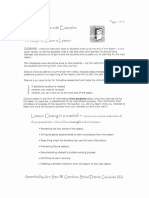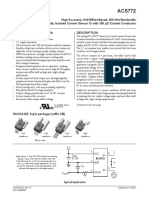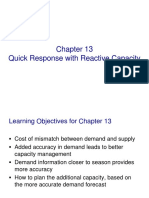Drilling Procedures DD
Drilling Procedures DD
Uploaded by
Aditya FadilCopyright:
Available Formats
Drilling Procedures DD
Drilling Procedures DD
Uploaded by
Aditya FadilOriginal Title
Copyright
Available Formats
Share this document
Did you find this document useful?
Is this content inappropriate?
Copyright:
Available Formats
Drilling Procedures DD
Drilling Procedures DD
Uploaded by
Aditya FadilCopyright:
Available Formats
INTRODUCTION
In the case of Exploration and Resource Definition Diamond drilling (DD), it is essential
to collect core samples for geochemical analysis. This activity requires that no non-rig
personnel are allowed to operate near the rig. The purpose of this SOP is to:
Communicate the hazards associated with sampling in Diamond Drilling;
Document the control measures that will be used to control the hazards
associated with this activity.
Implement appropriate documentation and procedure in drilling operation and
handling of drill core samples.
Implement proper procedure to maintain accurate and precise datas acquisition.
Coordinate daily-weekly operational planning to lessen downtime.
Define the required qualifications of personnel performing the operation.
This SOP applies to the following PT MSM / TTN Departments and contractors:
Exploration Department
The following equipment covered under this SOP:
DIAMOND DRILLING
This SOP is designed to cover the safety (mobilization, setting-up and drilling operation),
proper sampling and handling of drill cores in the drill rigs.
HAZARD AND RISK
The principal hazards associated with this activity include:
Proximity to rotating parts/machinery ;
Proximity to hydraulic hoses;
Noise
SAFETY INDUCTION
All drilling personnel shall undergo all necessary required Safety Induction
Trainings prior to commencing of work.
Prior to any operation, all drilling equipment will undergo safety and technical
inspection thru MSM/TTN commissioning team.
PERSONAL PROTECTIVE EQUIPMENT
A Hard Hat, Safety Shoes, Earplugs, Gloves and Safety or Protection Goggles are the
minimum Personal Protective Equipment required for any person working at a drill site.
All persons visiting a drill site must also wear the required PPEs.
Each personnel working at a drill site shall be issued a set of basic PPE.
The proper use, care and maintenance of the PPEs shall be the responsibility of
its user.
All PPEs must be in good condition with no signs of failure or damage. Any signs
of failure or damage shall be reported to their immediate supervisor, who shall
make sure the damaged PPE is replaced without delay.
Use the PPE only as intended.
After use, store the PPEs properly.
DRILLING MANAGEMENT
Exploration and Mine Development Drilling programs are handled by Exploration
Department. Geologists responsible for the day to day drilling activities will be assisted
by Field Assistants and Supervisors. Each drilling shift should be watched and overseen
by a Field Assistant.
Geologist Duties
1. Access and Drill Pads
Assisted by Field Assistants, organized and manage drill pad preparation as required
in the drilling programs including communication with the drill pad and rig road
contractors.
All drill pads will be inspected both by representative from Exploration and Contractor
for safety and hazard identification prior to drilling.
2. Drill Set-up and Precision
Assisted by Field Assistants/Supervisors, proper marking/pegs and line-up of drill
direction on drill pad will be done before rig mobilize. The peg with flagging tape
includes information on propose drill hole number, azimuth, inclination and target
depth.
Communicate and liase with drilling contractor on how the drilling should be
conducted. Drilling plan should be informed to the drilling contractor representative
as clear as possible prior to the drilling commencement at each planned drill holes.
The information of drill holes should be provided to the drilling contractor at the same
time to field assistant in charge of the rig with the use of Rig Mobilization Form
(RMF). The RMF consist of sketch on location of the Drill Pad, Propose Hole ID,
Hole ID, Azimuth, Inclination and Target depth (See Figure 1)
Lining up of rig will be supervised by Geologist/Field Assistant/Supervisors based on
pre-installed string/rope. Final set-up must not exceed 2 of the desired target
azimuth.
Leveling of rig and set-up of inclination will be supervised by the Geologist/Field
Assistant/Supervisors. Final set-up must not exceed 2 the desired target inclination.
The Geologist/Field Assistant/Supervisors and Drill Supervisor shall sign-off the RMF
to acknowledge the accuracy and precision of the rig set-up and drilling target.
3. Drill Core Handling and Documentation
The Geologist must ensure that the Field Assistant in-charge is familiar in recording
core recovery of every drilling run
% Core Recovery = (total length of core in meters /drilling run in
meters) x 100
Geologist/Field Assistant/Supervisors will ensure that the Contractor shall clearly
mark in permenant marker the hole number and tray number on the vertical end of
each tray from which the cored interval starts. The start and end direction of the
cored intervals for each tray shall be clearly marked in the same position for each
tray using an arrow.
Each tray shall have wooden or plastic blocks marked with the measured rod depth
at the end of each core run. Measurement of drill runs shall be in meters and
decimals of a meter (Insert photo of Core Marking).
Each tray is to be secured with a lid and straps after it is filled then stacked
conveniently and safely for pickup by Company personnel.
Where the core is broken to fit into the core tray, Geologist/Field Assistant will make
sure that the contractor has clearly mark the break in with a cross in yellow colour
pencil.
A wooden or plastic block should be inserted in the tray at the depth where each
core orientation survey is taken.
A marker block should be placed in the core tray at the depth where core was lost
and clearly marked LOST CORE and the drilled depth from and to (Insert photo of
Lost Core).
For geotechnical drilling the Contractor will be required to lay up the core retained in
the split sets at the drill site on a V-rail supplied by the Company on retrieval of each
core run.
4. Daily Drilling Activity Report
The Geologist must make sure that the Field Assistant in charge understands how to
record drilling activities (dropped core, standby, water/circulation loss, etc.), OHSE,
incident and other matters that might affect the drilling operations.
The Geologist will make sure the timely submission of daily drilling activity report and
core recovery log form for database input.
When drilling is completed, make sure that Field Assistant in duty count the number
of drill rods sunk, and cross check if they are matched up with the total depth
recorded.
5. After Drilling.
After drilling is complete the Geologist/Field Assistant/Supervisors will ensure that
the collar will be cemented, labeled and properly capped.
Collar survey will be immediately done and submit results to Database section.
The Geologist/Field Supervisor will make sure immediate pad and access
rehabilitation upon confirmation that the location will not be drilled for the time being.
You might also like
- SOP DrillingDocument19 pagesSOP DrillingHongKyz Jovianz X-BoyzNo ratings yet
- Drill and Blast QAQC ProcessDocument1 pageDrill and Blast QAQC ProcessProsper AabullehNo ratings yet
- BGM-MIN-SOP1129 - Long Hole Open Stopping Procedure - Rev4Document27 pagesBGM-MIN-SOP1129 - Long Hole Open Stopping Procedure - Rev4Paul Nyabisi100% (1)
- ZJ70-4500 DBS Drilling Rig User ManualDocument46 pagesZJ70-4500 DBS Drilling Rig User ManualAhmed Magd100% (1)
- Directional Drilling and Deviation Control Technology Ebook: Click HereDocument3 pagesDirectional Drilling and Deviation Control Technology Ebook: Click HereMansi Panwar100% (1)
- Drilling Operation & Hazards Analysis PDFDocument343 pagesDrilling Operation & Hazards Analysis PDF李建100% (9)
- Attachment A Route Survey Checklist SheetDocument1 pageAttachment A Route Survey Checklist SheetJennifer WangNo ratings yet
- SQ Mark & 100ppm ChecklistDocument14 pagesSQ Mark & 100ppm Checklistkarpags100% (3)
- SOP-D-005 Rotary Core Drilling (Wireline and Conventional)Document9 pagesSOP-D-005 Rotary Core Drilling (Wireline and Conventional)johnson Olubi100% (1)
- Reverse Circulation DrillingDocument6 pagesReverse Circulation DrillingHabib Ur Rahman100% (2)
- Wire Line Safety GuidanceDocument29 pagesWire Line Safety GuidancePaul Ninian75% (4)
- Core BarrelsDocument10 pagesCore Barrelsrtnty100% (1)
- Aeci Mining Explosives Product Catalogue Surface Bulk Emulsions 2019 OctoberDocument14 pagesAeci Mining Explosives Product Catalogue Surface Bulk Emulsions 2019 OctoberMohamed Badian Traore0% (1)
- Exon Mobile Drilling Guide PDFDocument318 pagesExon Mobile Drilling Guide PDFPwint Phoo100% (5)
- Drilling Rig Safety Inspection Check ListDocument17 pagesDrilling Rig Safety Inspection Check ListKiryaki Francis100% (2)
- Section 3.0.2 Core Drilling Hazard Inspection ListDocument3 pagesSection 3.0.2 Core Drilling Hazard Inspection ListAndi Mangaraja Lubis0% (1)
- 1-Coveralls, 2-Gloves, 3-Safety Boots, 4-Safety Hard Hat 5-Safety Glasses, 6-Full Body Safety Harness & 7-Derrickman's BeltDocument3 pages1-Coveralls, 2-Gloves, 3-Safety Boots, 4-Safety Hard Hat 5-Safety Glasses, 6-Full Body Safety Harness & 7-Derrickman's BeltkhurramNo ratings yet
- Precision Drilling International Task Risk Assessment WorksheetDocument1 pagePrecision Drilling International Task Risk Assessment WorksheetAbdul Hameed OmarNo ratings yet
- Responsibilities During Drilling OperationsDocument1 pageResponsibilities During Drilling OperationsYougchu LuanNo ratings yet
- Drilling Safety ManualDocument23 pagesDrilling Safety ManualAlvaro MadridNo ratings yet
- Ground Control in Open Pit Mines: Code of PracticeDocument34 pagesGround Control in Open Pit Mines: Code of PracticemuhammadkamaraNo ratings yet
- Kibali 2018 (055 055)Document1 pageKibali 2018 (055 055)faldoNo ratings yet
- Surface Exploration Drilling Checklist: Guidance NoteDocument5 pagesSurface Exploration Drilling Checklist: Guidance NoteZulfiqar HyderNo ratings yet
- 13 SWPDocument11 pages13 SWPAshfaq AhmadNo ratings yet
- 006 RC Drilling Induction PDFDocument29 pages006 RC Drilling Induction PDFhassan bachu100% (1)
- PGF-001 Blast Guard ProcedureDocument6 pagesPGF-001 Blast Guard ProcedureBenito Lionel ZoboNo ratings yet
- WC-SLR Rig Move: Checklist Date: Auditor NameDocument4 pagesWC-SLR Rig Move: Checklist Date: Auditor NameMarko BravoNo ratings yet
- Drilling SOPDocument19 pagesDrilling SOPM Ocky Bayu NugrohoNo ratings yet
- Table of Contents Iadc Safety Meeting TopicsDocument4 pagesTable of Contents Iadc Safety Meeting TopicsfarisNo ratings yet
- Drilling Summary Report-Jan 2020 - Jabal Sayid-Surface Diamond-Ct-14Document1 pageDrilling Summary Report-Jan 2020 - Jabal Sayid-Surface Diamond-Ct-14Asif KhanzadaNo ratings yet
- Ground Control in Open Pit MinesDocument34 pagesGround Control in Open Pit MinesSansão FofeteNo ratings yet
- Drilling Hse AuditDocument54 pagesDrilling Hse AuditQHSE ManagerNo ratings yet
- Lecture Note 2 - Overview Petroleum Engineering UpdatedDocument57 pagesLecture Note 2 - Overview Petroleum Engineering Updatedmohamadijambk22No ratings yet
- Running TubingDocument3 pagesRunning TubingAbdul Hameed OmarNo ratings yet
- 10 - Drilling 8.5 in HoleDocument2 pages10 - Drilling 8.5 in HoleMohamed AbozeimaNo ratings yet
- Pre Spud Checklist 1Document2 pagesPre Spud Checklist 1Ali AlakariNo ratings yet
- Drilling Assignment Presentation G2Document37 pagesDrilling Assignment Presentation G2Ega Puspita Leriana100% (3)
- Drilling and Workover Division FinalDocument15 pagesDrilling and Workover Division FinalThem Bui XuanNo ratings yet
- Drilling Safety: David Calvert, True Oil Enterprises IncDocument16 pagesDrilling Safety: David Calvert, True Oil Enterprises Inccall_mustafas2361100% (1)
- Man Set 005 R08Document10 pagesMan Set 005 R08Jorge MoralesNo ratings yet
- Rig Floor SafetyDocument1 pageRig Floor Safetykhurram100% (1)
- BOP Nipple Down 17-May-2010Document1 pageBOP Nipple Down 17-May-2010HAMDI RAFIEK100% (2)
- Rig Move Hazards IADC 7-18-13Document16 pagesRig Move Hazards IADC 7-18-13Hafed HafedNo ratings yet
- Advert - Graduate GeologistDocument3 pagesAdvert - Graduate GeologistJoseph buluguNo ratings yet
- Coring ProcedureDocument18 pagesCoring ProcedureRoy100% (4)
- Oil Field Drill Rig Safety (HSE)Document34 pagesOil Field Drill Rig Safety (HSE)omer dafallah50% (2)
- Scope of Works-TSF Ore Rehandling To ROM PadDocument6 pagesScope of Works-TSF Ore Rehandling To ROM Padgeorgesways247No ratings yet
- HSE Manual of Drilling & ExplorationDocument73 pagesHSE Manual of Drilling & ExplorationFahruddin RahmatNo ratings yet
- Drilling BitsDocument19 pagesDrilling Bitsado_bajricNo ratings yet
- SOP-Handling of MisfireDocument5 pagesSOP-Handling of MisfiremanojNo ratings yet
- Bits Drilling GuidelinesDocument8 pagesBits Drilling GuidelinesNeil46100% (2)
- Daily Checks (Floorman)Document1 pageDaily Checks (Floorman)Abdul Hameed OmarNo ratings yet
- Chapter 10-ADocument4 pagesChapter 10-AMahrouz MadoNo ratings yet
- Drilling MethodsDocument2 pagesDrilling MethodsAndi FirdausNo ratings yet
- List of Components of Oil Drilling RigsDocument9 pagesList of Components of Oil Drilling RigssamirgoranNo ratings yet
- Dyno Nobel Underground Products Services and Reference GuideDocument36 pagesDyno Nobel Underground Products Services and Reference GuideDOC LABNo ratings yet
- PGL.methodology Askeaton WWTP Upgrade SI Nov 24Document4 pagesPGL.methodology Askeaton WWTP Upgrade SI Nov 24shamen AmarasekaraNo ratings yet
- Directional Drill SafetyDocument7 pagesDirectional Drill SafetyMartahan ManurungNo ratings yet
- Dsop 08 SOPDocument3 pagesDsop 08 SOPwingwidiatmokoNo ratings yet
- Procedure - HS011-Rotary-CoringDocument6 pagesProcedure - HS011-Rotary-CoringRasulNezNo ratings yet
- Wellsite ManualDocument88 pagesWellsite Manualvisuhari100% (1)
- CPT 04Document18 pagesCPT 04Aditya FadilNo ratings yet
- Cone Penetration Test: ASTM D3441Document1 pageCone Penetration Test: ASTM D3441Aditya FadilNo ratings yet
- CPT Log: Cone Penetration Test (CPT)Document1 pageCPT Log: Cone Penetration Test (CPT)Aditya FadilNo ratings yet
- CPT Log: Cone Penetration Test (CPT)Document1 pageCPT Log: Cone Penetration Test (CPT)Aditya FadilNo ratings yet
- Lampiran A Curah Hujan Lokasi PenelitianDocument5 pagesLampiran A Curah Hujan Lokasi PenelitianAditya FadilNo ratings yet
- Stuff 2Document2 pagesStuff 2PA PlantNo ratings yet
- Eng Midterm ReviewDocument14 pagesEng Midterm ReviewSarah YangNo ratings yet
- HCPT - JKT: Huawei Technologies Co., LTDDocument4 pagesHCPT - JKT: Huawei Technologies Co., LTDyogi perbowoNo ratings yet
- General Dynamics F-111 Aardvark - WikipediaDocument24 pagesGeneral Dynamics F-111 Aardvark - WikipediaJacob Miller100% (1)
- Happiness Is Like A HugDocument26 pagesHappiness Is Like A HugSrinivas KalaNo ratings yet
- 01-SAMMS-046 Stainless PipeDocument11 pages01-SAMMS-046 Stainless PipesureshNo ratings yet
- Slab Design (Cantilever, One Way, Two Way & Continuous)Document6 pagesSlab Design (Cantilever, One Way, Two Way & Continuous)sharathkn50% (2)
- Transport Phenomena Fluid Mechanics Problem Solution BSL - Annular Flow of Newtonian Fluid With Inner Cylinder Moving Axially - Wire Coating DieDocument5 pagesTransport Phenomena Fluid Mechanics Problem Solution BSL - Annular Flow of Newtonian Fluid With Inner Cylinder Moving Axially - Wire Coating DieyudhaputraNo ratings yet
- Closure TechniquesDocument3 pagesClosure TechniquesBernardita Erames GutibNo ratings yet
- BOQ - Sinha Fabric Kuril Retrofitting - 26-12-2017Document3 pagesBOQ - Sinha Fabric Kuril Retrofitting - 26-12-2017zakaria200811060No ratings yet
- Fuchs 19 + The Experience of Time and Its Disorders (OUP Chap.48)Document12 pagesFuchs 19 + The Experience of Time and Its Disorders (OUP Chap.48)td.bernateauNo ratings yet
- Sutherland Cranial Magazine 2010Document32 pagesSutherland Cranial Magazine 2010Jennifer SteinbachsNo ratings yet
- GMDSS-STCW-GOC-FCC-El-7: Test Pool, Questions and Answers. (Answers, Bottom of Page) July 2006Document100 pagesGMDSS-STCW-GOC-FCC-El-7: Test Pool, Questions and Answers. (Answers, Bottom of Page) July 2006Lokesh KumarNo ratings yet
- Philippine Popular CultureDocument17 pagesPhilippine Popular Cultureeric generaleNo ratings yet
- Housing Society Project by 12 StudentDocument20 pagesHousing Society Project by 12 StudentAryan MehteleNo ratings yet
- ACS772 DatasheetDocument46 pagesACS772 DatasheetfsrdNo ratings yet
- Froztec Recold MCDocument8 pagesFroztec Recold MCErixon RamírezNo ratings yet
- Training Manual For Dogs: Classical ConditioningDocument6 pagesTraining Manual For Dogs: Classical Conditioningmckenzie wilsonNo ratings yet
- Chap 13Document15 pagesChap 13Kevin RaderNo ratings yet
- BiophilicApproachtoArchitectureCaseoftheAlhambraal Andalus PDFDocument177 pagesBiophilicApproachtoArchitectureCaseoftheAlhambraal Andalus PDFVijaya LakshmiNo ratings yet
- June 2023 SANTA MARTA MARINA AND BEACH FRONT PROPERTY THROUGH FASTBLOC BUILDING SYSTEMDocument14 pagesJune 2023 SANTA MARTA MARINA AND BEACH FRONT PROPERTY THROUGH FASTBLOC BUILDING SYSTEMLUZ MOSNo ratings yet
- Warehouse EquipmentDocument21 pagesWarehouse EquipmentSarin Paraparakath100% (1)
- Republic of The Philippines Department of EducationDocument4 pagesRepublic of The Philippines Department of Educationkristine100% (1)
- GoStore - IG Ads Pitch DeckDocument13 pagesGoStore - IG Ads Pitch DeckaarielNo ratings yet
- Design Milestones Review ChecklistsDocument17 pagesDesign Milestones Review ChecklistsAzhari RachmanNo ratings yet
- Reducing Runway Landing OverrunsDocument8 pagesReducing Runway Landing OverrunsAnonymous R0s4q9X8No ratings yet
- Theories of FailureDocument23 pagesTheories of FailureDheerajGunwant25% (4)
- FCC Regulations Part 97 PDFDocument2 pagesFCC Regulations Part 97 PDFChristopherNo ratings yet
- Wartsila O E RT Flex60c MIMDocument376 pagesWartsila O E RT Flex60c MIMNirmal Raj Chopra100% (1)





























































































